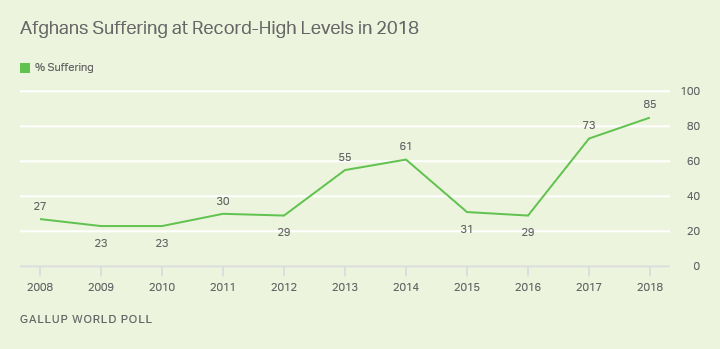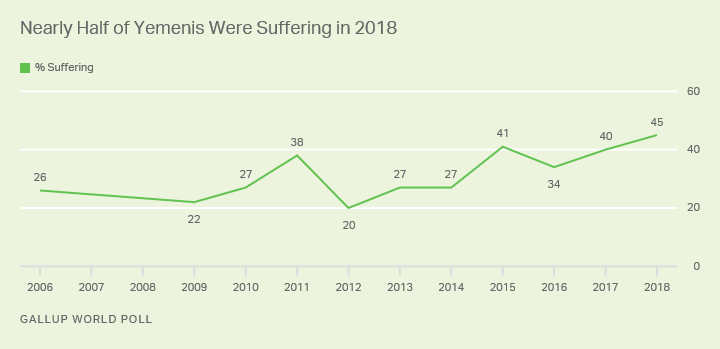2020 is just one week old and already off to a fast news start. By no means an exhaustive list, here are some of the big data trends and storylines Gallup editors will be watching throughout the rest of the year:
Migration
Four years after the peak of the migrant crisis in Europe and on the other side of the signing of the global migration compact, is the world more or less accepting of migrants? Is the U.S. still one of the most-accepting countries? Gallup will answer these questions later this year when we release the results from our second global administration of the Migrant Acceptance Index.
Amid the backlash against migrants in the wake of the European migrant crisis, Gallup developed the Migrant Acceptance Index to gauge people's acceptance of migrants not only in Europe, but also throughout the rest of the world.
The results from the inaugural index found the countries on the front lines of the migrant crisis were among the least-accepting countries in the world for migrants, with most located along the Balkan route that once channeled asylum-seekers from Greece to Germany. Many of these countries also rejected signing the Global Compact for Migration in late 2018.
| Least accepting of migrants | Most accepting of migrants | ||||||||||||||||||||||||||||||||||||||||||||||||||||||||||||||||||||||||||||||||||||||||||||||||||
|---|---|---|---|---|---|---|---|---|---|---|---|---|---|---|---|---|---|---|---|---|---|---|---|---|---|---|---|---|---|---|---|---|---|---|---|---|---|---|---|---|---|---|---|---|---|---|---|---|---|---|---|---|---|---|---|---|---|---|---|---|---|---|---|---|---|---|---|---|---|---|---|---|---|---|---|---|---|---|---|---|---|---|---|---|---|---|---|---|---|---|---|---|---|---|---|---|---|---|---|
| Macedonia | 1.47 | Iceland | 8.26 | ||||||||||||||||||||||||||||||||||||||||||||||||||||||||||||||||||||||||||||||||||||||||||||||||
| Montenegro | 1.63 | New Zealand | 8.25 | ||||||||||||||||||||||||||||||||||||||||||||||||||||||||||||||||||||||||||||||||||||||||||||||||
| Hungary | 1.69 | Rwanda | 8.16 | ||||||||||||||||||||||||||||||||||||||||||||||||||||||||||||||||||||||||||||||||||||||||||||||||
| Serbia | 1.80 | Canada | 8.14 | ||||||||||||||||||||||||||||||||||||||||||||||||||||||||||||||||||||||||||||||||||||||||||||||||
| Slovakia | 1.83 | Sierra Leone | 8.05 | ||||||||||||||||||||||||||||||||||||||||||||||||||||||||||||||||||||||||||||||||||||||||||||||||
| Israel | 1.87 | Mali | 8.03 | ||||||||||||||||||||||||||||||||||||||||||||||||||||||||||||||||||||||||||||||||||||||||||||||||
| Latvia | 2.04 | Australia | 7.98 | ||||||||||||||||||||||||||||||||||||||||||||||||||||||||||||||||||||||||||||||||||||||||||||||||
| Czech Republic | 2.26 | Sweden | 7.92 | ||||||||||||||||||||||||||||||||||||||||||||||||||||||||||||||||||||||||||||||||||||||||||||||||
| Estonia | 2.37 | United States | 7.86 | ||||||||||||||||||||||||||||||||||||||||||||||||||||||||||||||||||||||||||||||||||||||||||||||||
| Croatia | 2.39 | Nigeria | 7.76 | ||||||||||||||||||||||||||||||||||||||||||||||||||||||||||||||||||||||||||||||||||||||||||||||||
| Note: Based on 138 countries surveyed in 2016; U.S. and Canada surveyed in 2017; top possible score is 9.0 | |||||||||||||||||||||||||||||||||||||||||||||||||||||||||||||||||||||||||||||||||||||||||||||||||||
| Gallup World Poll | |||||||||||||||||||||||||||||||||||||||||||||||||||||||||||||||||||||||||||||||||||||||||||||||||||
Global Leadership
The image of U.S. leadership was in poor shape worldwide in 2017 and 2018. What does it look like ahead of the next presidential election? Will the leadership of Russia and China continue to gain global clout? What about Germany, as longtime Chancellor Angela Merkel prepares to step down?
Gallup will continue to track its decade-plus trend of how the world views the leadership of the U.S., Germany, China and Russia and will examine the regions where each of them has the most strength and weakness.

Stress, Anger and Worry
More people worldwide were stressed, worried and angry in 2018 than they've been at most points over the past decade that Gallup has been monitoring these emotions. This was particularly true in the U.S., where a majority of Americans (55%) said they had experienced stress during a lot of the day, nearly half (45%) said they felt worried a lot and more than one in five (22%) said they felt angry a lot.
But are they as stressed and angry today? Or even more so? Find out how Americans are doing -- and how the rest of the world feels -- when Gallup updates its annual global barometer on emotions.

Global Hotspots for Suffering
GDP and other traditional income-based metrics that measure economic growth don't tell us enough on their own, and they certainly do not guarantee growth that is inclusive and sustainable -- which is where wellbeing metrics, including people's evaluations of their lives, help fill in the blanks.
Gallup classifies individuals as "thriving," "struggling" or "suffering" based on how they rate their current and future lives using a ladder scale with steps numbered from zero to 10 (based on the Cantril Self-Anchoring Striving Scale).
In 2018, at least one in three people in five countries -- Afghanistan, Yemen, Haiti, Iran and Ukraine -- rated their lives so poorly that they were considered suffering.
| Thriving | Struggling | Suffering | |||||||||||||||||||||||||||||||||||||||||||||||||||||||||||||||||||||||||||||||||||||||||||||||||
|---|---|---|---|---|---|---|---|---|---|---|---|---|---|---|---|---|---|---|---|---|---|---|---|---|---|---|---|---|---|---|---|---|---|---|---|---|---|---|---|---|---|---|---|---|---|---|---|---|---|---|---|---|---|---|---|---|---|---|---|---|---|---|---|---|---|---|---|---|---|---|---|---|---|---|---|---|---|---|---|---|---|---|---|---|---|---|---|---|---|---|---|---|---|---|---|---|---|---|---|
| % | % | % | |||||||||||||||||||||||||||||||||||||||||||||||||||||||||||||||||||||||||||||||||||||||||||||||||
| Afghanistan | -- | 15 | 85 | ||||||||||||||||||||||||||||||||||||||||||||||||||||||||||||||||||||||||||||||||||||||||||||||||
| Yemen | 5 | 50 | 45 | ||||||||||||||||||||||||||||||||||||||||||||||||||||||||||||||||||||||||||||||||||||||||||||||||
| Haiti | 14 | 46 | 40 | ||||||||||||||||||||||||||||||||||||||||||||||||||||||||||||||||||||||||||||||||||||||||||||||||
| Iran | 12 | 54 | 34 | ||||||||||||||||||||||||||||||||||||||||||||||||||||||||||||||||||||||||||||||||||||||||||||||||
| Ukraine | 14 | 53 | 33 | ||||||||||||||||||||||||||||||||||||||||||||||||||||||||||||||||||||||||||||||||||||||||||||||||
| Gallup World Poll, 2018 | |||||||||||||||||||||||||||||||||||||||||||||||||||||||||||||||||||||||||||||||||||||||||||||||||||
In war-torn Afghanistan, a record-high 85% of Afghans rated their lives so poorly in 2018 that they were considered suffering. This is notably also the highest percentage that Gallup has ever recorded for any country in the past decade. No Afghans rated their lives highly enough to be considered thriving.

Although relatively high percentages of Yemenis have been considered suffering since civil war broke out in 2015, the 45% of Yemenis who were suffering in 2018 represents a new high for that country. This number has edged higher as the civil war rages on and Yemenis suffer from food shortages and disease outbreaks. More than six in 10 Yemenis (61%) struggled to afford food for their families in 2018.

Haiti rounds out the top three countries with the highest levels of suffering in the world, with four in 10 Haitians rating their lives poorly enough in 2018 to fall into this category. High percentages of Haitians have been in distress for years, even before the devastating hurricane in 2016. That year, Haiti had the second-highest level of suffering of any country in the world.

While several of the countries with the highest levels of suffering have been hotspots for years or even decades, some have faded from the news in recent months. However, given the high levels of suffering in these countries and the fact that many of them play host to or are involved in unresolved conflicts, they remain places to watch in 2020.




